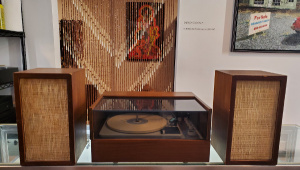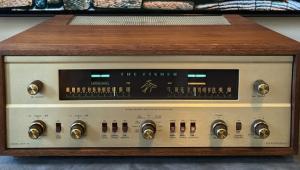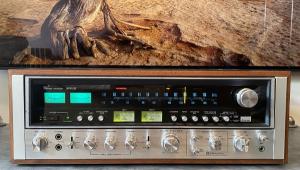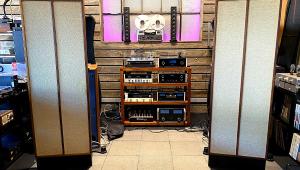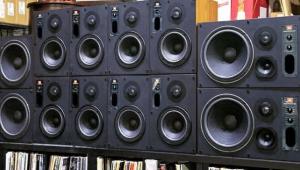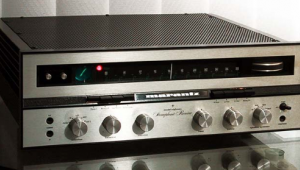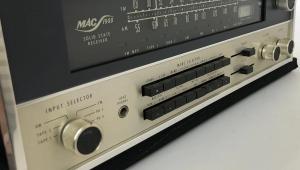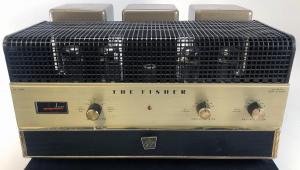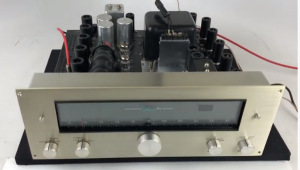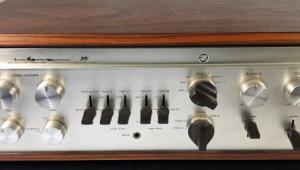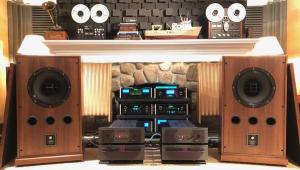The Mighty Marantz 2500: A Commanding Presence
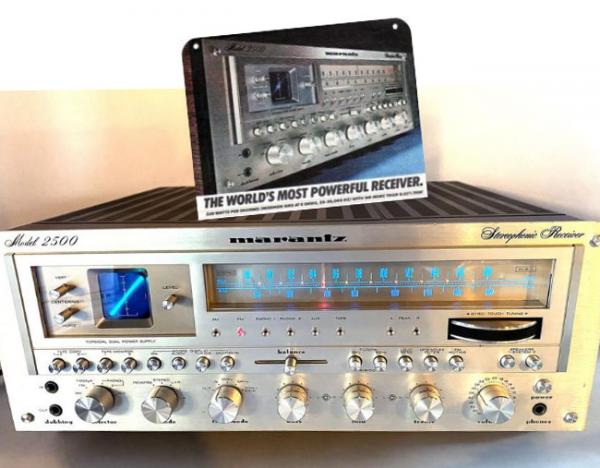
Marantz discontinued the Model 2500 more than 40 years ago yet this stunningly beautiful stereo receiver is still a commanding presence. Emblematic of flagships from the mid to late 1970s, the 2500 is an evolution of the iconic ’60s-era Model Eighteen and was hailed as “The World’s Most Powerful Receiver” in magazine ads of the day.
It wasn’t hype.
Produced from 1977 to 1980, the Model 2500 is noteworthy not just for its engaging industrial design but for its front-panel oscilloscope — novel then and now — distinctive, free-spinning “Gyro-Touch Tuning” dial, dual phono inputs, and (then) unheard-of power output of 250 watts per channel, which prompted Pioneer, Sansui and other top brands of the day to respond with their own monster receivers. Indeed, the Marantz 2500 outperformed the best flagship receivers of the day, delivering twice as much power as top competitors like Sansui’s 125-watt 9090DB. Clean power. Pioneer’s SX-1250, another contender, topped out at 160 watts a side.
As Marantz explained in its 1977 brochure, the 250-watt spec was “minimum continuous watts per channel, with no more than 0.05% total harmonic distortion [a first for receivers], both channels driven in to 8 ohms.” Drop impedance to 4 ohms, and output jumped to 330 watts with no appreciable increase in distortion. Credit goes to the quadruple push-pull Class AB output section, a design used in separate components, but never before in receivers.
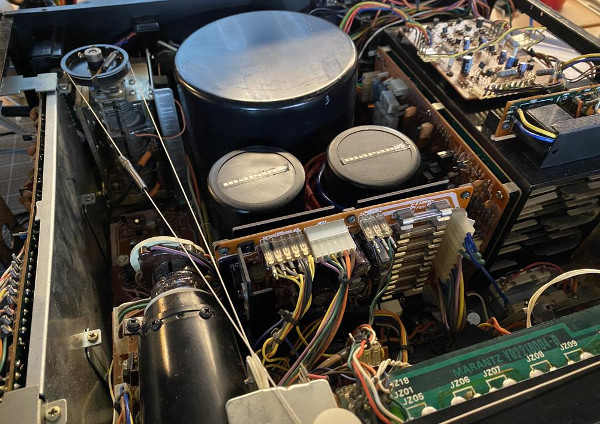
The design was a source of great price for Marantz as was the use of a large toroidal power supply with separate windings for the left and right channels, which accounted the bulk of the 2500’s 60 pounds. “Even when one channel is driven by a high-level dynamic signal demanding considerable output, the other can still maintain exceptionally low distortion.”
To keep the power amplifier section from overheating — a real concern, given the power at hand — Marantz deployed “space-age heat dissipators.” Instead of the massive (and impractical) heat sinks that would otherwise be required for an amplifier of this size, output transistors are mounted inside a tunnel with a fan that draws air across the transistors and the finger-like “pin fins” attached to each device. An ingenious solution. Marantz explained: “The result is a receiver capable of reliable long-term operation, even under full power output conditions. It is, moreover, a receiver that’s remarkably compact and lightweight for the amount of power it can deliver.”
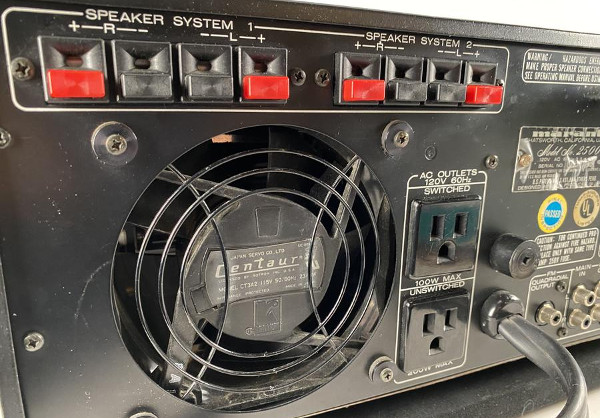
Compact is relative because at 19 x 17 x 7 inches, the 2500 is certainly big — just not as big as other flagships of the day, including the gargantuan Sansui G-33000 it inspired, which one-upped the Model 2500, delivering 300 watts a side from a two-piece “receiver.” Not to take away from the formidable engineering behind the G-33000 but I don’t see how it qualifies a receiver, the whole point of which is to house everything in a single chassis. Even the Sansui 9090DB was a couple inches wider, though its rated power potential was half that of the 2500.
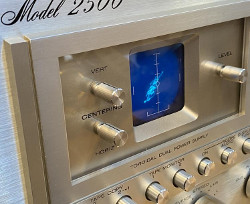 The presence of a true oscilloscope on its front panel — a tool for accurately tuning AM and FM stations to improve stereo separation and reduce signal degradation from multipath — set the 2500 apart from its contemporaries as did the excellent five-gang tuner itself with its dual-gate MOSFET front end and ability to pull in and lock onto radio signals with great precision. But the parade of compelling features doesn’t end there.
The presence of a true oscilloscope on its front panel — a tool for accurately tuning AM and FM stations to improve stereo separation and reduce signal degradation from multipath — set the 2500 apart from its contemporaries as did the excellent five-gang tuner itself with its dual-gate MOSFET front end and ability to pull in and lock onto radio signals with great precision. But the parade of compelling features doesn’t end there.
Adding to the Model 2500’s allure is the well-considered phono preamp with its two complementary input differential amplifiers, low-noise transistors, to name but two elements of its design. And then you have the dual-knob tone controls for adjusting bass, midrange, and treble for each channel. Intriguing, though it doesn’t strike me as terribly useful.
Highly Sought After
Ten years ago you could pick up a working Marantz Model 2500 for less than two grand. Not anymore. Remarkably, the best remaining examples of the 2500 — those that are fully and impeccably restored — can cost as much as the 2500 did when it came out in 1977, which is to say around seven grand when the original list price of $1,600 is adjusted for inflation.
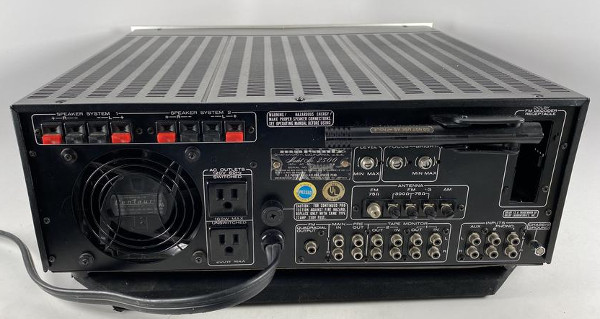
A quick internet search revealed three specimens: a non-working “parts” model offered on eBay for $2,500 (the auction ended without a sale on November 9), a “fully restored and fully recapped” model offered on reverb.com for $4,500, and a “full blown restoration” carried out by the vintage audio specialists at New Jersey’s SkyFi Audio that tips the scales at $6,999.
SkyFi owner Fernando Zorrilla confides that the newly restored Marantz Model 2500 was acquired years ago from an audiophile in Newark and set aside in anticipation of a rebuild. “The market and demand for the large flagship receivers has been steadily increasing so we thought it would be worth the effort,” he explains.
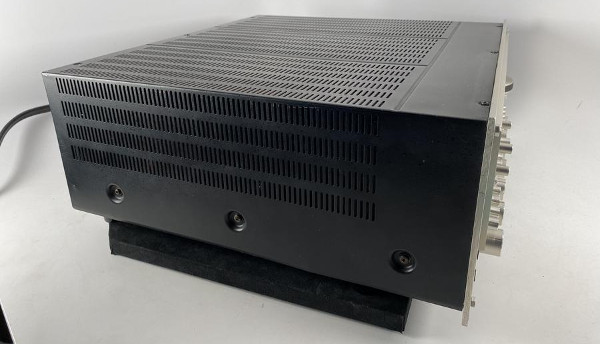
So why is the asking price so steep?
Zorrilla is quick to point to the receiver’s near-perfect condition and cites the “countless hours required to fully restore one of these monsters,” which, in part, involved recapping all of its electrolytic capacitors (except for those on the tuner board), verifying that the original main filter capacitors are in good working order, upgrading all of its tiny lamps to LED, aligning its AM and FM tuners, and replacing semiconductors and trimmers on the amplifier boards, refreshing the thermal compound on its output transistors, and using an ultrasonic process to clean all of its knobs. On a scale of 1 to 10, Zorrilla rates the restored 2500’s working condition a 10 and its physical condition an 8.
“The Model 2500 is special because it’s a one of the largest receivers from one of the best companies at the time,” Zorrilla informs. “And the oscilloscope brings additional interest and collectability.”
